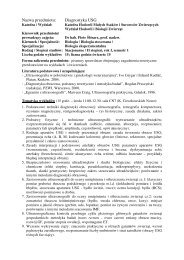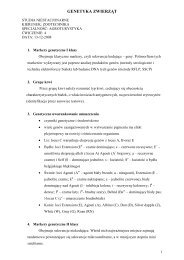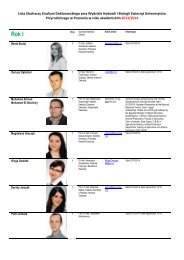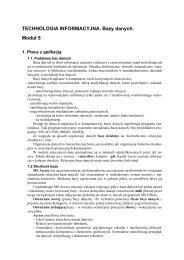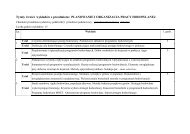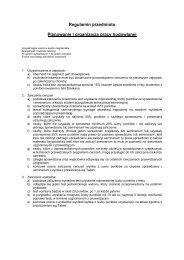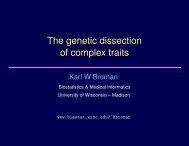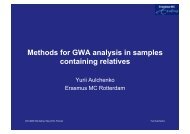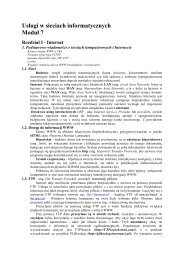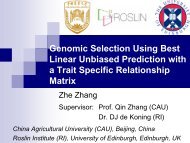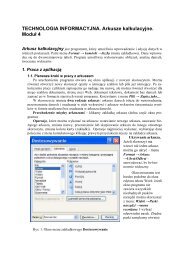The book of abstracts is available. - PoznaÅ
The book of abstracts is available. - PoznaÅ
The book of abstracts is available. - PoznaÅ
You also want an ePaper? Increase the reach of your titles
YUMPU automatically turns print PDFs into web optimized ePapers that Google loves.
14 th QTL-MAS Workshop, Poznań University <strong>of</strong> Life Sciences, Poland 2010Genomic selection using Best Linear Unbiased Prediction with a traitspecific relationship matrixZhe Zhang 1,2∗ , Xiangdong Ding 1 , Jianfeng Liu 1 , Dirk-Jan de Koning 2 , Qin Zhang 11 Key Laboratory <strong>of</strong> Animal Genetics and Breeding <strong>of</strong> the Min<strong>is</strong>try <strong>of</strong> Agriculture, College <strong>of</strong> Animal Scienceand Technology, China Agricultural University, Beijing, 100193, China2<strong>The</strong> Roslin Institute and Royal (Dick) School <strong>of</strong> Veterinary Studies, University <strong>of</strong> Edinburgh, Roslin, EH259PS, UK∗ Presenting author: Zhe Zhang, email: zhangzhecau@126.comBackground. Using the common dataset publ<strong>is</strong>hed from the XIV QTL-MAS workshop, threemethods for estimating genomic breeding values (GEBVs) <strong>of</strong> a quantitative trait werecompared: best linear unbiased prediction with a trait specific relationship matrix (TA-BLUP), ridge regression best linear unbiased prediction (RR-BLUP), and BayesB.Methods. TA-BLUP <strong>is</strong> a method that <strong>is</strong> identical to the conventional BLUP method exceptthat the numeric relationship matrix <strong>is</strong> replaced with a trait specific relationship matrix (TA).<strong>The</strong> TA matrix <strong>is</strong> constructed based on both marker genotypes and their estimated effects onthe trait <strong>of</strong> interest. <strong>The</strong> marker effects were estimated in a reference population cons<strong>is</strong>ting <strong>of</strong>2,326 individuals using RR-BLUP and BayesB and the GEBVs <strong>of</strong> individuals <strong>of</strong> the referencepopulation as well as 900 young genotyped individuals were estimated using the threemethods. Subsets <strong>of</strong> markers were selected to perform low-density marker genomic selectionfor TA-BLUP method.Results. <strong>The</strong> correlations between GEBVs from different methods are over 0.95 in mostcases. <strong>The</strong> correlation between BayesB and TA-BLUP using 200 selected markers toconstruct the TA matrix <strong>is</strong> 0.98 in the candidate population.Conclusions. TA-BLUP provides the possibility to use low-density markers for estimatingGEBVs in candidate populations. Using only a small proportion <strong>of</strong> the total markers, selectedon the bas<strong>is</strong> <strong>of</strong> their estimated effects, TA-BLUP gives GEBVs that are almost equivalent tothat from RR-BLUP or BayesB. TA-BLUP <strong>is</strong> therefore a prom<strong>is</strong>ing method for genomicselection in the candidate populations because <strong>of</strong> the remarkably reduced cost for genotyping,even though there might be a little loss <strong>of</strong> accuracy.33



